Running between the estuaries of the Kyu-Kitakami River (former Kitakami River) and the Abukuma River, the Teizan Canal is Japan’s longest canal, and was built in a 327-year project that commenced in 1557. In August 2022, a temporary “one-day” bridge emerged over this 46.4 kilometer waterway.
The bridge that was washed away by the tsunami after the Great East Japan Earthquake was rebuilt, after eleven years, with a pontoon made of raft boats, stretching across the canal that flows through the Shinhama district, a coastal town in the Miyagino Ward of Sendai, Miyagi Prefecture (Figure 1). The initiative came to life as part of the Sendai in Progress art project started by artist, Kawamata Tadashi.
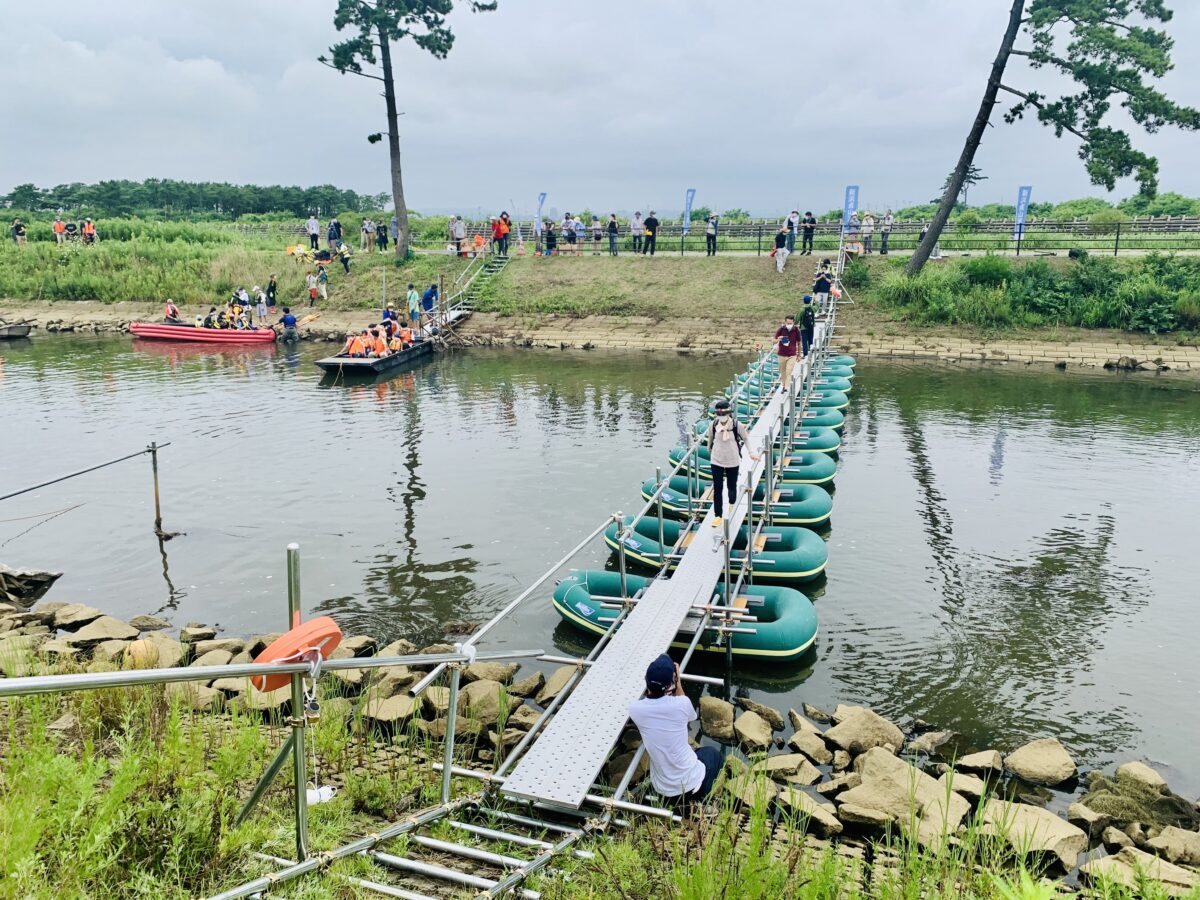
Figure 1. KAWAMATA Tadashi, Floating Bridge (temporary), photo by author.
The method of making a bridge by laying a slab over connected boats have existed throughout the history of both western and oriental cultures. Pontoon bridge is also depicted in a relief scene in Emperor Trajan’s column, which was developed around 98-117 CE and influenced later memorial columns (Figure 2). In Japan, pontoon bridges have also appeared in poems from the Man’yōshū, the oldest extant collection of Japanese waka, as well as woodblock prints of the Sino-Japanese War made by Kunitoshi Baiou (Figure 3).
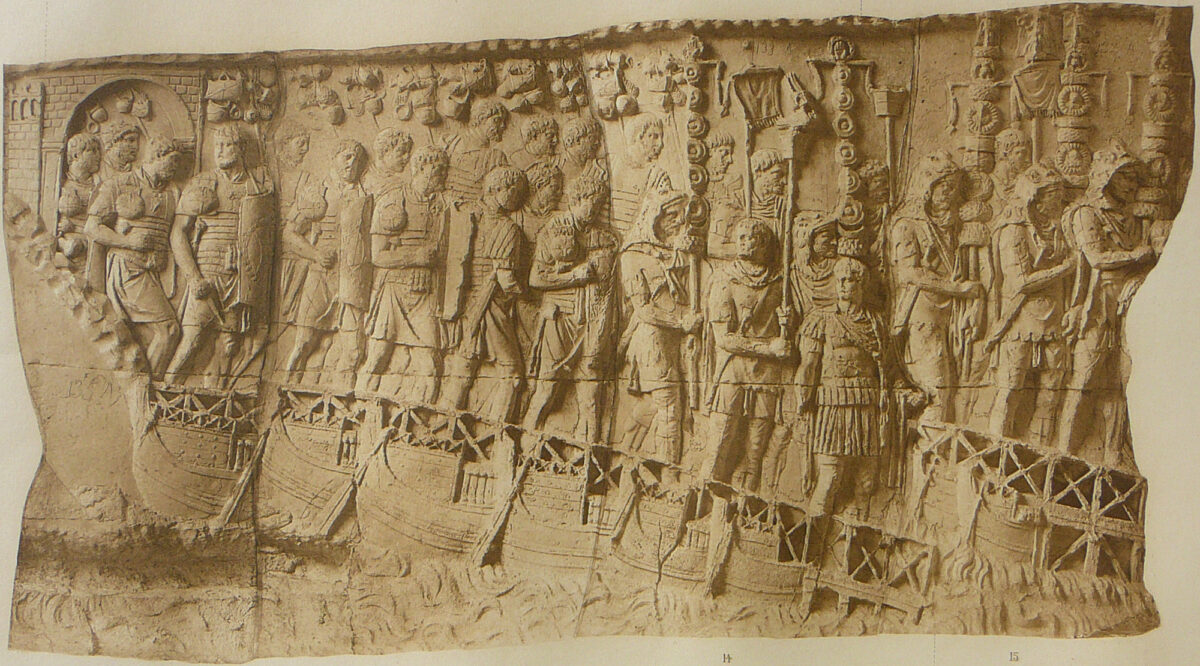
Figure 2. Pontoon bridge sculpted on the column of Emperor Trajan. Wikimedia Commons.
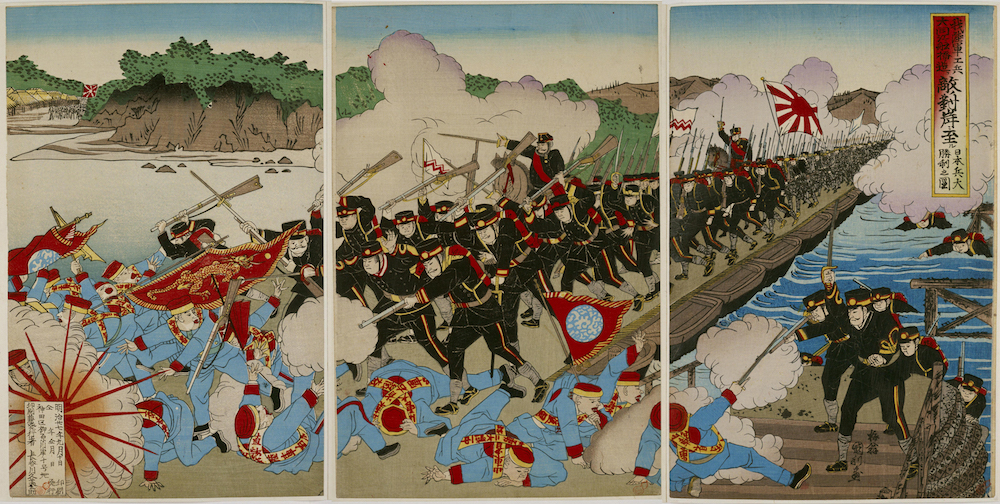
Figure 3. Kunitoshi Baiou, Color woodblock print scene of the Japanese force’s great victory at Sino-Japanese War. The army built a pontoon over the Taedong River to cross to the enemy’s land. 1894. Collection of the National Diet Library.
Sendai in Progress is a long-term project, which was launched in 2017. Now reaching its 6th year, the project started with the local residents’ longing for the bridge lost in the tsunami has evolved into the Bridge for All: an initiative to build a bridge over the Teizan Canal.
Kawamata Tadashi’s Bridge for All is rooted in his other work, Home for All. Immediately after the earthquake, Kishin no kai, a group organized by five volunteer architects, proposed the initiative to build wooden community houses in the earthquake-hit towns, with Toyo Ito, Kazuyo Sejima and Riken Yamamoto taking the lead on the design and construction. The first house was built in October 2011 in the temporary housing area for residents who had lost their homes in the earthquake. The house was moved to a new location in April 2017, and given a new name: Home for All in Shinhama. Since then, the house has been used as a hub for community rebuilding programs and other resident activities.
While the Bridge for All served as a core activity in the Sendai in Progress project, it was a rocky path getting to that point. The original bridge was built by local town volunteers to provide residents with access across the waterway, but rebuilding it over the canal as permanent architecture faced some issues. As a result, the project followed several different developmental stages.
In 2018, Kawamata’s team unveiled Boat for All, serving as a row boat across the Teizan Canal, transporting passengers between the two shores. A year later, Wood Path for All presented a trail in the windbreak forest that stretched towards the shore overlooking the Sendai Bay. The boardwalk can also be used as a bench from which to view the monument of Hachidai ryūō, (the Eight Great Dragon Kings, water deities in Japanese mythology), which was erected to offer prayers for maritime safety and pleasant sea travels. The boardwalk extends further, to the site of the Forest Appreciation Monument, or the Airin stone monument, dedicated to the contributors to the 1950s windbreak forest construction initiative. As such, the timber passage leads the way towards the local histories represented by the two landmarks.
In 2020, another trail was built to lead to the inland area, connecting both sides of the canal from a horizontal perspective. In April 2022, Shinhama Tower was completed, providing a birds-eye view of the pinewoods, marsh, embankments, and the horizon of the Teizan Canal. A few months later, the long-time plan finally bore fruit with the bridge being built across the waterway. The idea to use a pontoon bridge, and the design and construction method, came out of continued discussions between Kawamata, his team and the Shinhama town residents.
Since 2021, I have been given opportunities to observe Sendai in Progress on several occasions. During my initial visits to the site, Kawamata joined us virtually, due to the pandemic border control that had prevented him from traveling to Japan from his home in Paris. In such a challenging time, I was particularly inspired by residents of the Shinhama district, who played a key role in the project.
For several years, local residents of the Shinhama district have regularly organized the Shinhama Footpath, where participants are invited to enjoy a walk along the Teizan Canal. Partnering with the Sendai in Progress project and its sponsor, the Sendai Mediatheque, the unique event offers a range of fun activities for the public. The enthusiasm of the community members, their devotion to the event, and their eager support of the art project radiated an energy that radically overwrites the stereotype of public being mere guests in an artist-initiated project.
Kawamata Tadashi is a leading Japanese artist who has pioneered art projects since the 1980s. Rather than simply looking at completed works, these art projects emphasize the creative processes that link all events and relationships, and have made a breakthrough in art history where development had previously been primarily based on artwork collected in museums.
Meanwhile, working closely with community rejuvenating efforts led by the local government, similar art projects began to gain popularity in different parts of Japan. Despite often facing harsh public criticism that questions the artistic significance of projects that are arguably aimed at exploitation in the name of “public engagement” or “community initiative”, the heart of Sendai in Progress held in the Shinhama district was undaunted by such opinions.
The team named the pontoon made in this activity Floating Bridge (temporary). Japanese culture has long embraced the word “bridge” as a metaphor for a variety of expressions. As seen in the line of the 17th century Kyogen play that read “One cannot cross without a bridge (things will not move smoothly without someone to mediate), the Japanese term for bridge is used to convey liaision or the mending of a broken relationship.
Indeed, this goes back to why Kawamata’s makeshift bridge isn’t just about rebuilding the broken bridge; it is an attempt to reconnect what was disconnected, tying us to our involvement with natural disasters, such as tsunami and earthquakes, through our living experiences. At the same time, pontoon bridges also have a remarkable history.
The pontoon bridge sculpted on the memorial column of Emperor Trajan in Rome is said to have been used by the Roman army to cross the Danube River during their attack of Dacians in the First Dacian War (101-102 CE). The boat bridge was also recorded in Kunitoshi Baiou’s colorful wood print of the battle over the Taedong River, which stretched from the north-western region of the Korean Peninsula and through the city of Pyongyang.
Since ancient times, the development of pontoon bridges has paralleled its use in the military. The Iran-Iraq War, or more recently, the Russian invasion of Ukraine, are some of the contemporary cases where a floating bridge was used as a military technique. Leading the history of humans and the buoyant platform, Floating Bridge (temporary) was completed in the notable year of 2022, as if to suggest the true possibility that the act of linking can reunite a division, as opposed to leading to destruction and plunder.
I would now like to explore another interpretation of Sendai in Progress.
At 2:46 pm on March 11, 2011, the country’s largest earthquake ever recorded hit Japan’s Tohoku region off the Pacific Ocean. After eleven years, unique community exhibition spaces, called the Shinsai Densho facilities (震災伝承施設), have opened throughout the region in the hope of preserving the materials that testify to the tragic experience. The term Shinsai Densho stemmed from the Japanese tradition of using oral lore to transmit the knowledge of natural disasters to posterity. The word has appeared frequently in activities related to the Tohoku earthquake. Amidst the disaster still leaving its mark in many of these towns, each facility takes a different approach, with some utilizing the preserved building that survived the earthquake, while others introduce art projects, as well as contemporary artworks, in an effort to explore ways to pass down stories to new generations.
In English, the Tohoku earthquake is often translated as the Great East Japan Earthquake. Its original name is, however, Higashi Nihon Daishinsai, which means East Japan Great Earthquake Disaster. Apparently, the last word, Daishinsai or Earthquake Disaster, is not the same as earthquake, as it connotes tsunami as well as the damage caused by the Fukushima nuclear power plant crisis which occurred shortly after the earthquake. As of October 2022, there are around 309 Shinsai Densho facilities around the Tohoku region. As part of their initiative to raise public awareness of the facilities, the Ministry of Land, Infrastructure, Transport and Tourism call the collective sites of these museums 3.11 Densho Road. Nonetheless, most of them focus only on tsunami damage and less than 0.1% of them, to my knowledge, cast light on the truth about the nuclear incident and its victims.
With these facilities highlighting the damage from the tsunami, I cannot help but wonder how we can communicate the real story of the nuclear disaster and individual suffering and experiences of the victims. How can we preserve the voices of the people who were exposed to the invisible threat of radiation? Isn’t it necessary to carefully discern what has been blurred in the name of “Shinsai Densho”?
Here, another fact regarding the prevailing trend of emphasizing “densho” becomes prominent and cannot be ignored. Surprisingly, nearly all the Shinsai Densho facilities call themselves a “memorial” facility in English. For example, the exhibition space that was opened in the school building of Kesennuma Koyo High School in Miyagi’s Kesennuma City—the school that was damaged severely by the tsunami—is translated as the Ruins of the Great East Japan Earthquake Kesennuma City Memorial Museum.
Even the facility operated by Fukushima Prefecture, one of the rare cases where its name includes the word “nuclear”, is “Great East Japan Earthquake and Nuclear Disaster Memorial Museum” when translated into English.
Now, let’s take a look at some examples of Japanese facilities that use the word “memorial” in their English names.
広島平和記念資料館 Hiroshima Peace Memorial Museum
広島平和記念公園 Hiroshima Peace Memorial Park
国立長崎原爆死没者追悼平和祈念館 Nagasaki National Peace Memorial Hall for the Atomic Bomb Victims
沖縄県平和祈念資料館 Okinawa Prefectural Peace Memorial Museum
阪神・淡路大震災記念 人と防災未来センター The Great Hanshin-Awaji Earthquake Memorial Disaster Reduction and Human Renovation Institution
What these examples reveal is that before the 2011 earthquake, the English word “memorial” had been translated into the Japanese words 記念 (kinen; to commemorate) or 祈念 (also pronounced kinen; to pray). As more and more Shinsai Densho facilities opened, the translation of the English word was adjusted to add densho —the Japanese word for passing down the experience to the future—to the meaning for “memorial”. For Japan, this change is measurable, and this very project, Sendai in Progress, holds the key to uncover its true implications.
Of all the art projects held in the disaster areas, Sendai in Progress stands out as an unparalleled endeavor. Many experiments are taking place through this project, where medium and long-term timeframes are set, and process is given priority. It is not only an exploration of the memories of the disaster-stricken land and the experiences of the people and their preservation, but also a practice to cultivate a new way of densho through creativity to revive history and culture, rather than focusing solely on a goal of passing down the records of the disaster.
When I set foot on Wood Path for All, the inspiration behind the Bridge for All, it reminds me of Suzuki Harunobu’s allusion to Yatsuhashi from Tales of Ise (Figure 4). Rendered as a parody to the tales of men nostalgic for their homelands in classic literature, the Edo period Ukiyo-e artist turned the characters to female.
The boat and the trail built as part of the art project both have a clear purpose —moving people from one point to another, be it on land or over the water. At the same time, Kawamata’s project links not only places but times, as the wooden path connected the Eight Great Dragon Kings monument and the Airin stone monument. These works of art— the path, the bridge, and the watchtower— not only serve within their original functions but further deliver the power of allusion.
The Arahama district was deemed uninhabitable after it was designated a disaster risk area, meaning that construction or renovation of residential buildings is restricted due to the danger of tsunami damage. The local citizen’s group who protested about the Ward’s disaster recovery effort under the cover of forced displacement was reportedly disbanded in 2018.
As for the Ido district, the local newspaper, Kahoku Shimpo, published an article on July 24, 2022, highlighting the disparity of the recovery efforts seen among the different tsunami-hit areas. The article stated that the number of households in the Ido districts has decreased to 10% of its pre-disaster population, leaving the former residential zone desolated, in contrast to other areas.
The Teizan Canal binds together these regions with their different realities surrounding their recovery. It is for this reason that the bridge and the trail that Kawamata built around the riverbank, through its power of allusion, can become the gateway to the future that we have yet to see. Beyond the path and the floating boats, we may find a new way of rethinking the tragic past and the concept of memorials, along with what lies behind commemoration, prayer, and densho. That’s the way I see it (Figure 5).
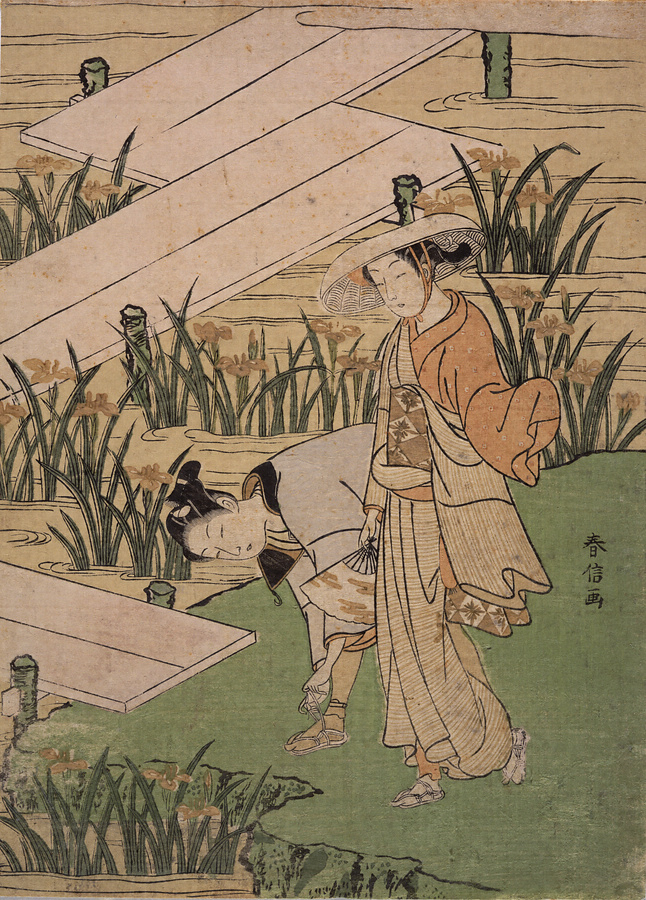
Figure 4. SUZUKI Harunobu, Mitate Ise Monogatari Yasuhashi (Allusion to the “Yatsuhashi” Chapter from “Tales of Ise”), Edo Period, 18th Century, Collection of Tokyo National Museum.
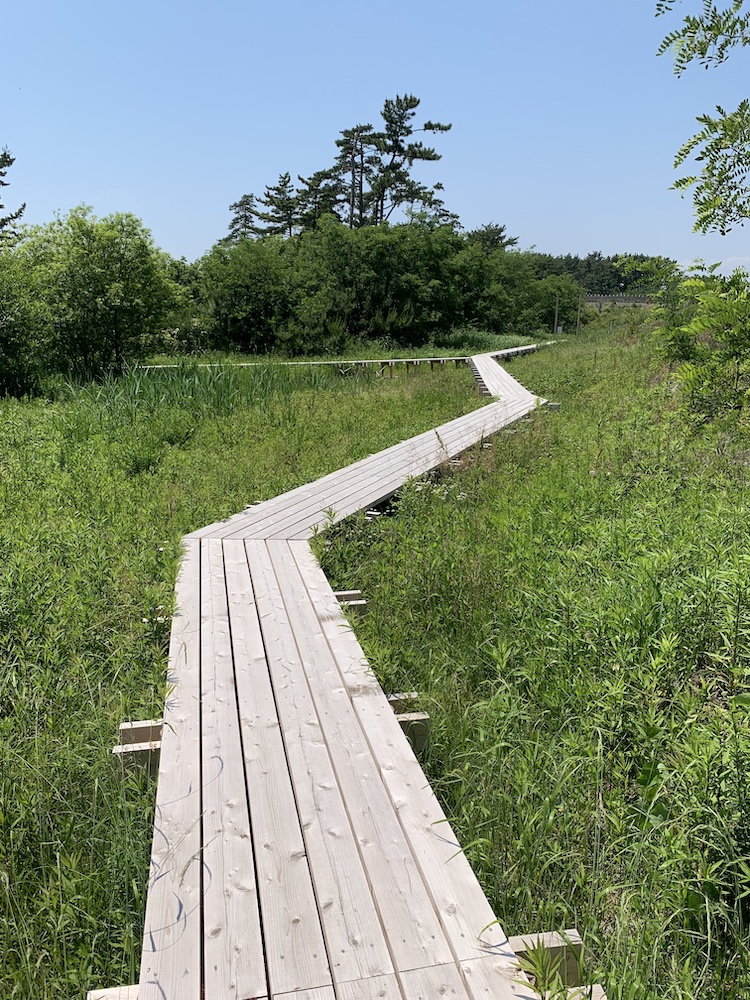
Figure 5. KAWAMATA Tadashi, Wood Path for All, photo by author